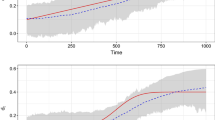Abstract
In this paper, we introduce an adjusted blockwise empirical likelihood (ABEL) method for long memory time series models. By dividing time series into blocks and by adding an appropriate adjustment term, we construct the ABEL ratio and the confidence interval for the mean of the process. Under mild conditions, we show that Wilks’ theorem still holds for the ABEL ratio by choosing a specific block correction factor. The Monte Carlo simulation studies are reported to assess the finite sample performance of the proposed ABEL method.
Similar content being viewed by others
References
Bravo F (2009) Blockwise generalized empirical likelihood inference for non-linear dynamic moment conditions models. Econom J 12:208–231
Chen J, Variyath AM, Abraham B (2008) Adjusted empirical likelihood and its properties. J Comput Graph Stat 17:426–443
Chen SX (1994) Comparing empirical likelihood and bootstrap hypothesis tests. J Multivar Anal 51:277–293
Chen SX (1994) Empirical likelihood confidence intervals for linear regression coefficients. J Multivar Anal 49:24–40
Chen SX, Hall P (1993) Smoothed empirical likelihood confidence intervals for quantiles. Ann Stat 21:1166–1181
Davydov YA (1970) The invariance principle for stationary processes. Theory Probab Appl 15:487–498
DiCiccio T, Halland P, Romano J (1991) Empirical likelihood is bartlett-correctable. Ann Stat 19:1053–1061
Emerson C, Owen AB (2009) Calibration of the empirical likelihood method for a vector mean. Electron J Stat 3:1161–1192
Gamage RDP, Ning W, Gupta AK (2017) Adjusted empirical likelihood for long-memory time-series models. J Stat Theory Pract 11:220–233
Geweke J, Porter-Hudak S (1983) The estimation and application of long-memory time series models. J Time Ser Anal 4:221–238
Giraitis L, Koul HL, Surgailis D (2012) Large sample inference for long memory processes. Imperial College Press, London
Kitamura Y (1997) Empirical likelihood methods with weakly dependent processes. Ann Stat 25:2084–2102
Kolaczyk ED (1994) Empirical likelihood for generalized linear models. Stat Sinica 4:199–218
Liu Y, Chen J (2010) Adjusted empirical likelihood with high-order precision. Ann Stat 38:1341–1362
Nordman DJ, Sibbertsen P, Lahiri SN (2007) Empirical likelihood confidence intervals for the mean of a long-range dependent process. J Time Ser Anal 28:576–599
Owen AB (1988) Empirical likelihood ratio confidence intervals for a single functional. Biometrika 75:237–249
Owen AB (1991) Empirical likelihood for linear models. Ann Stat 19:1725–1747
Qin J, Lawless J (1995) Estimating equations, empirical likelihood and constraints on parameters. Can J Stat 23:145–159
Wu R, Cao J (2011) Blockwise empirical likelihood for time series of counts. J Multivar Anal 102:661–673
Yau CY (2012) Empirical likelihood in long-memory time series models. J Time Ser Anal 33:269–275
Zhong B, Rao J (2000) Empirical likelihood inference under stratified random sampling using auxiliary population information. Biometrika 87:929–938
Acknowledgements
We sincerely wish to thank the two referees for their queries and many insightful remarks and suggestions which have led to improving the presentation of the results.
Author information
Authors and Affiliations
Corresponding author
Additional information
This work was supported by National Natural Science Foundation of China (NSFC) Grants 11671194, 11171147 and 11501287.
Appendix
Appendix
Proof of Theorem 1
Let \(Z_{li}=T_{li}-\mu _0\), \(1\le i \le N\), \(Z_{l,N+1}=-{A_N}{N}^{-1}\sum ^{N}_{i=1}Z_{li}\), and define \(M_{n{\mu }_0} \equiv \max _{1 \le i \le N} |Z_{li}|\). First we examine the magnitude of \(M_{n{\mu }_0}\). Note that
Moreover, by Assumption (A3) and Lemma 4 of Davydov (1970),
This, together with \(l^2/n=o(1)\), implies that
From Proposition 3.3.1 and Theorem 4.3.1 of Giraitis et al. (2012),
where \(c_0^2=c^2B(d, 1-2d)/(d(1+2d))\). Let \(a_t^2=t^{2d-1}c_0^2\), \(1\le t\le n\). Thus, by (3),
That is,
Next, we consider \(|\lambda _{\mu _0}|\), which is the solution of the equation
Let \(\bar{Z}_{n\mu _0}=(N+1)^{-1}\sum ^{N+1}_{i=1}Z_{li}\) and \(\hat{S}^2_{l\mu _0}=N^{-1}\sum ^N_{i=1} Z_{li}^2\). Since
Proposition 2(a) of Nordman et al. (2007) and \(A_N=O(N^{\frac{1}{2}-d})\) imply that
Moreover, it follows from Proposition 2(b) of Nordman et al. (2007) that
From(5),
Combining this with (6) and (7), we arrive at
and therefore by (4),
Again from (5),
we obtain
where
Let \(\xi _i=\lambda _{\mu _0}Z_{li}\), \(1 \le i \le N+1\). (4) and (8) yield that
In addition,
This means that
Thus we find hat
In a similar way, by Schwartz inequality,
Let \(I=I_1+I_2\), we arrive at
By (10), we can assume that \(|\xi _i|<1,1 \le i \le N+1\). Then Taylor expansion yields that
and
where \(|v_i|\le \frac{1}{3}|\lambda _{\mu _0}|^3M_{n\mu _0}Z^2_{li}\) for \(1\le i\le N\) and
Since \(B_n=N^{-1}a_l^2a_n^{-2}\), we obtain
Now using (9), (12) and (13), and by (6), (7), (11) and (14), we find that
This completes the proof of Theorem 1. \(\square \)
Rights and permissions
About this article
Cite this article
Jiang, F., Wang, L. Adjusted blockwise empirical likelihood for long memory time series models. Stat Methods Appl 27, 319–332 (2018). https://doi.org/10.1007/s10260-017-0403-1
Accepted:
Published:
Issue Date:
DOI: https://doi.org/10.1007/s10260-017-0403-1
Keywords
- Adjusted blockwise empirical likelihood
- Confidence interval
- Long memory time series models
- Wilks’ theorem



